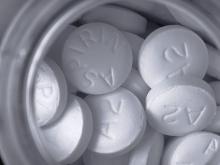ORLANDO – Aspirin sensitivity can be a real headache for patients and clinicians, but a safe and effective aspirin desensitization protocol can bring the analgesic and anti-inflammatory benefits of aspirin therapy to patients with aspirin-exacerbated respiratory disease, reported a clinician at the annual meeting of the American Academy of Allergy, Asthma, and Immunology.
Patients with AERD who undergo aspirin desensitization have fewer bouts of sinusitis, show improvement in both asthma symptoms and sense of smell, and use less corticosteroid, compared with patients who don’t undergo desensitization, said Dr. Katharine M. Woessner, program director in the division of allergy, asthma, and immunology at the Scripps Clinic in San Diego.
Aspirin desensitization also blunts the response to other NSAIDS like ibuprofen and naproxen, which – like aspirin – inhibit the cyclooxygenase-1 (COX-1) enzyme, Dr. Woessner said. Aspirin and other NSAIDs induce rhinitis and asthma attacks in patients with AERD, and the disease is progressive even when patients are careful to avoid all NSAIDs.
Only 3 of 1,400 consecutive patients with AERD that was treated with aspirin desensitization at Scripps experienced systemic reactions, and all of those responded to a single dose of intramuscular epinephrine, she said.
"I don’t know why aspirin desensitization works, but we clearly have a therapy that’s easy to use and is quite effective in managing these patients," Dr. Woessner said.
Aspirin Challenge
AERD usually begins in patients in their 30s or 40s who have a prior history of tolerance to aspirin and other NSAIDs. It is more than twice as likely to occur in women, and tends to be more severe in women than in men. Patients develop chronic congestion, rhinitis, anosmia, and nasal polyps, often followed by asthma 1-5 years after the onset of rhinitis.
The disease is characterized by chronic eosinophilic rhinosinusitis and nasal polyposis that are initially intermittent but evolve into chronic, hyperplasic eosinophilic sinusitis that often requires surgical intervention, Dr. Woessner said.
The asthma that develops in patients with AERD is persistent, usually moderate to severe, and related to the severity of sinus disease. However, "asthma is not necessarily a prerequisite to make a diagnosis of aspirin-exacerbated respiratory disease," she noted.
The clinical standard for AERD diagnosis is an oral aspirin challenge. Patients typically can experience a 20% or greater decline in FEV1 (forced expiratory volume in 1 second) and a naso-ocular reaction, but purely upper airway or lower airway reactions can also occur. Patients may also have a partial asthma reaction, with a change in FEV1 from baseline of –15% to –20% and a naso-ocular reaction or laryngospasm. Patients are considered to be negative for AERD if they have no reactions following a 325-mg oral aspirin challenge.
In those who test positive, treatment consists of avoiding all COX-1–inhibiting NSAIDS. Highly selective COX-2 inhibitors such as celecoxib (Celebrex) are generally well tolerated in patients with AERD, Dr. Woesnner said, noting that more than 200 AERD-proven patients at Scripps who were challenged with a highly selective COX-2 inhibitor had no reaction. However, cross reactivity is possible with higher doses of less-selective COX-2 inhibitors such as nimesulide (Sulide) or meloxicam (Mobic). Acetaminophen at doses up to 1,000 mg are also typically well tolerated in these patients.
"There are several drugs that don’t cross-react with aspirin in patients with AERD. The problem is that they’re not very good analgesics, so if we need something that’s analgesic or anti-inflammatory, patients are not going to get much benefit from these medications," Dr. Woessner said.
Outpatient Precautions
Aspirin challenge and desensitization in the outpatient setting can be safely performed with a few caveats. The patient should have stable asthma within 10% of the best prior value and an FEV1 of at least 60%-80% of predicted, or an output of at least 1.5 L. The patient should be on inhaled steroids and a long-acting beta-agonist, and 2-4 weeks before desensitization should be started on montelukast or another leukotriene modifier.
The advent of leukotriene inhibitors has made aspirin desensitization a routine outpatient procedure, session moderator Dr. Mariana C. Castells noted in an interview.
"We used to do aspirin desensitization in the intensive care unit, just because the reactions were scary and we didn’t know how to control them. In the last 10 years, since we started to use montelukast [Singulair] and Zyflo [zileuton], less than 1% have been done in an intensive care unit," said Dr. Castells of the division of rheumatology, immunology, and allergy at Brigham and Women’s Hospital in Boston.


